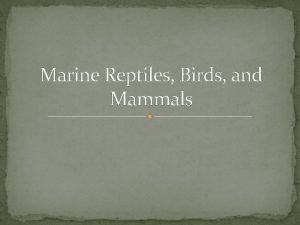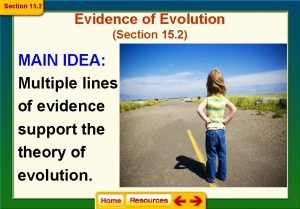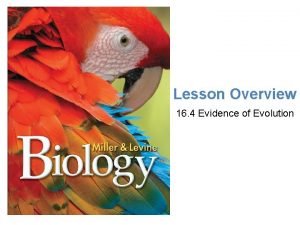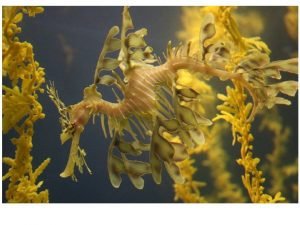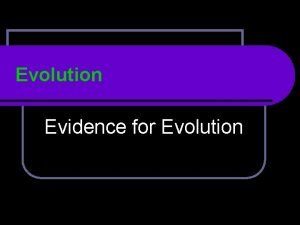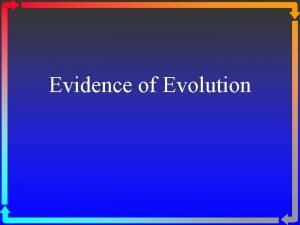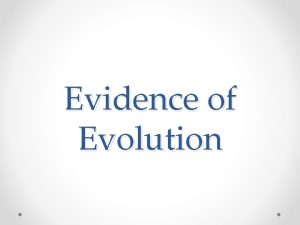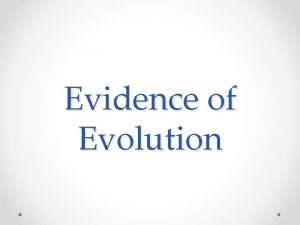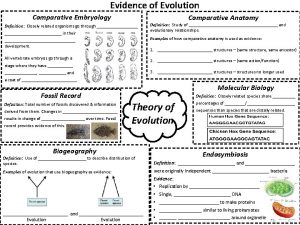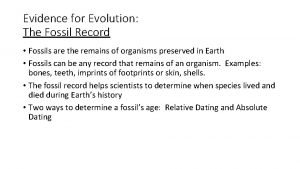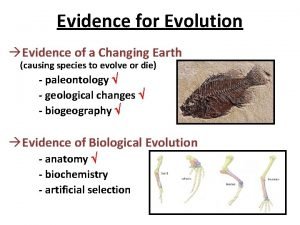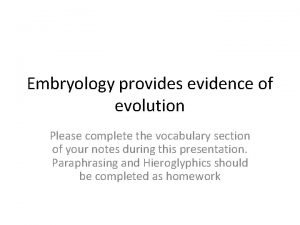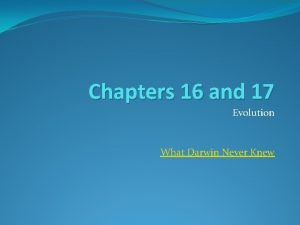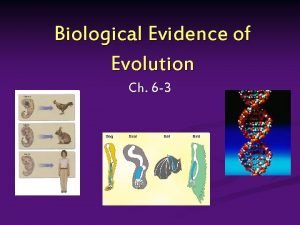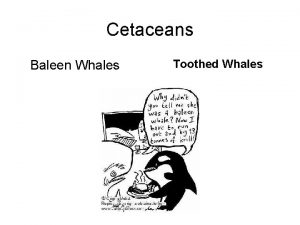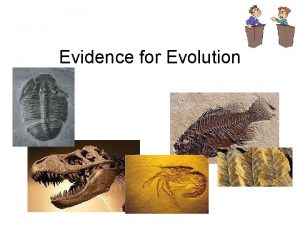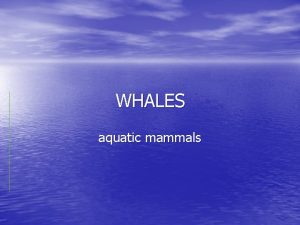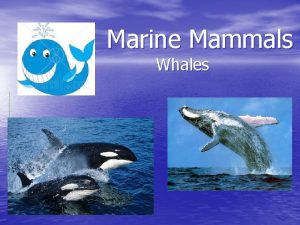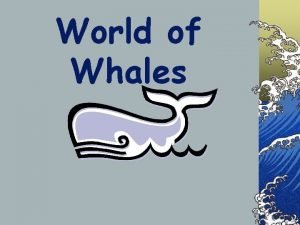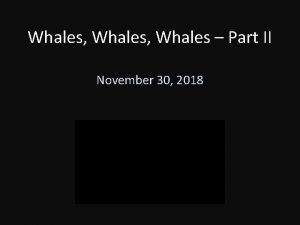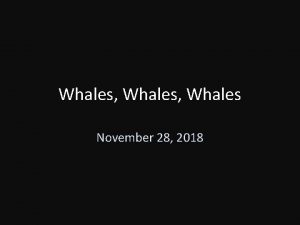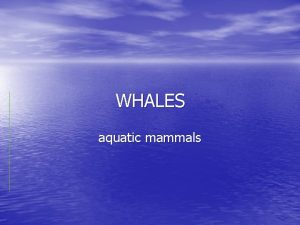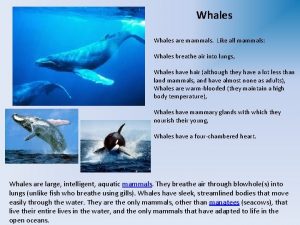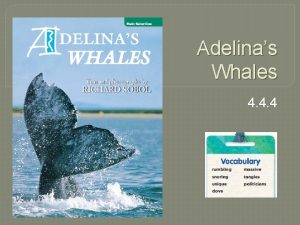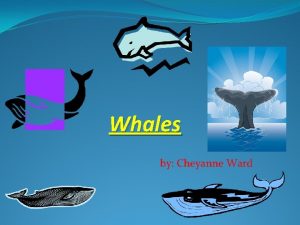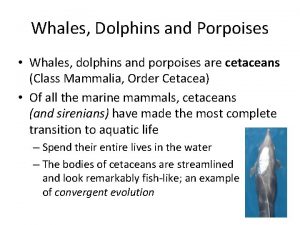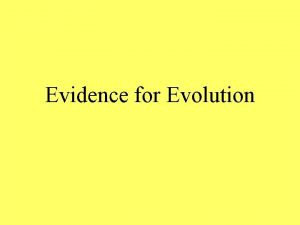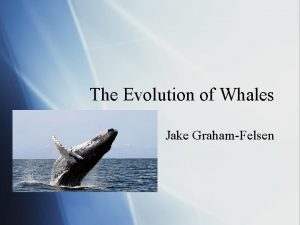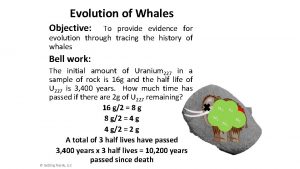Evolution of Whales Evidence Adapted from National Center


















- Slides: 18

Evolution of Whales Evidence Adapted from National Center for Case Study Teaching in Science

Order Cetacea (whales, dolphins, etc) Whales (blue whale) Dolphins (Atlantic spotted dolphin) Porpoises (Harbour porpoise) • Mammals specialized for aquatic lifestyle • Most are marine, some freshwater • Many are highly intelligent and social • Broadly separated into “toothed whales” and “baleen whales”

Cetaceans are Mammals • Warm-blooded + hair • Lungs + 4 -chamber heart • Placenta, live young + produce milk • Two nasal passages (with 1 or 2 blowholes) • Arm, wrist, & finger bones • Some with vestigial pelvis / legs • Tale moves vertically

Types of Evidence • Extant Organisms o o o o Living Organisms Structure – Direct Function – Direct Ecology – Direct Behavior – Direct Biochemistry – Direct Embryology – Direct • Extinct Organisms o o o Fossils Only Structure – Direct Function – Indirect Ecology – Indirect Behavior – Indirect

Fossil Evidence Reduction of hind pelvis and hind limbs Ambulocetus – Weight-bearing, but capable of swimming. Basilosaurus – Small, disarticulated, but relatively complete; digits I and II tiny or lost; some bones fused Modern sperm whale – Only a small bony remnant of pelvic bone

Fossil Evidence Change in eye position and nasal opening • Eye orbits (or. ) from dorsal (top) to lateral (side) • Nasal opening (nas. ) from snout tip to between eyes

Fossil Evidence Change in tooth structure • Reduction in tooth types from variety to single type • Increase in number of teeth

Fossil Evidence Paleoecology from O 18/O 16 ratios • • Lower values = freshwater/ Higher values = marine Pakicetids are freshwater Ambulocetids are transitional Protocetids are marine

Embryology Evidence Vestigial Hind Limbs • Spotted dolphin development • Hind limb (green circle) disappears by stage 17

Biochemical Evidence Comparing DNA Molecular studies show hippos are the closest living relative to cetaceans (i. e. , they are sister taxa). Deer Pig Camel Non-artiodactyl mammals • DNA Protein Trait Organism • If the organism changes (from new traits), DNA changes

Evolutionary Trees • Trees show both descent and relatedness • You and your sibling share a “common ancestor, ” your parent. • You are equally related to both of your cousins. • You did not descend from your siblings or cousins

Evolutionary Trees Sister taxa Terminal nodes, “tips, ” (or terminal taxa) (e. g. , B & C) A B C D E F G * ** Branch, or lineage The evolution of a particular trait is often marked with a hash. Internal nodes (= an ancestor of 2 lineages) Time Root * = common ancestor of E & F ** = common ancestor of (E&F) & G

Fossil Whales • Wolf size, terrestrial / semi. Pakicetus aquatic ~ 48 -52 million years ago (mya) • Brain case similar to cetaceans • Carnivore-like teeth; molars terrestrial, premolars whalelike • Terrestrial, near-stream (artist reconstruction) habitat; likely ventured in water to hunt fish

Fossil Whales Ambulocetus natans (“walking whale that swims”) ~ 49 mya • Size of large sea lion; large head, hind feet • Could walk (inefficiently) and also swim • Likely swam with spine undulation and hind-feet propulsion (mix between seal + whale) • Teeth intermediate, slightly more whale-like • Flexible elbows, wrists, digits (terrestrial feature). • Lived in coastal marine environment.

Fossil Whales Rodhocetus kasrani ~ 46 -47 mya • Reduced hind limbs, likely webbed toes • Limb/trunk swimmer with longer, more flexible vertebral column • Shallow, offshore marine habitat, but could support weight on land • Likely had a mandibular fat pad for underwater hearing. • Nostrils higher and farther back

Fossil Whales Basilosaurus species ~ 38 mya • Long (~56 feet), clearly aquatic, trunk swimmer • Hind limbs nearly complete but highly reduced & isolated from spine; possibly used for mating • Single nostril, more retracted but still intermediate. • Likely had large mandibular fat pad.

Fossil Whales Dorudon species ~ 37 mya • Fully marine • Hind limbs reduced + detached from spine • Hands as flippers; elbows slightly flexible • Caudal vertebrae flattened, consistent with tail fluke • Nostrils farther back • Teeth simple, more whalelike

Cetacean Evolutionary Tree
 Killer whale eating sea lion
Killer whale eating sea lion Evidence of evolution
Evidence of evolution Evidence for evolution doodle notes
Evidence for evolution doodle notes Section 15-2 evidence of evolution
Section 15-2 evidence of evolution Embryology evidence
Embryology evidence Molecular biology evidence of evolution
Molecular biology evidence of evolution Embryology evidence
Embryology evidence 4 types of evidence for evolution
4 types of evidence for evolution What are the 4 types of evidence for evolution
What are the 4 types of evidence for evolution What are the four types of evidence for evolution
What are the four types of evidence for evolution Anatomy and embryology evidence of evolution
Anatomy and embryology evidence of evolution Fossils evidence of evolution
Fossils evidence of evolution Evidence of evolution stations answer key
Evidence of evolution stations answer key Lamarck's theory of evolution
Lamarck's theory of evolution Embryology evidence of evolution
Embryology evidence of evolution Evidence for evolution
Evidence for evolution Charles darwin
Charles darwin 6 evidences of evolution
6 evidences of evolution Evidence of evolution
Evidence of evolution
